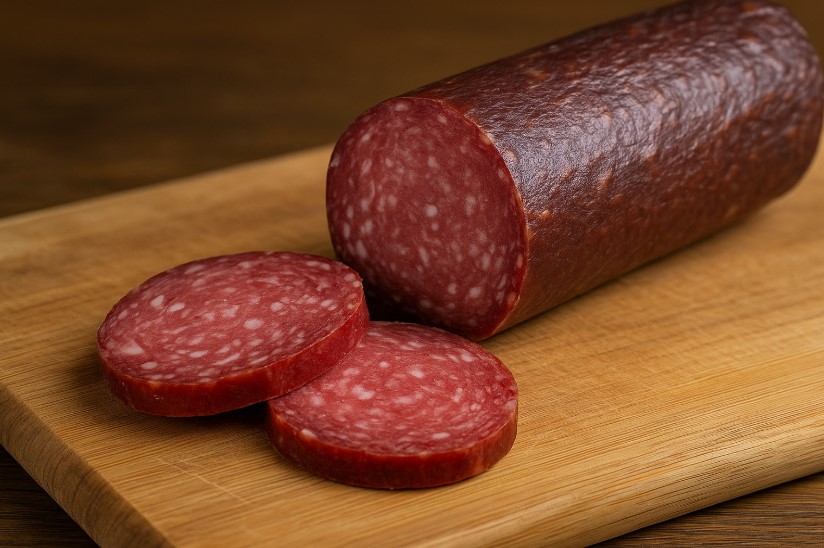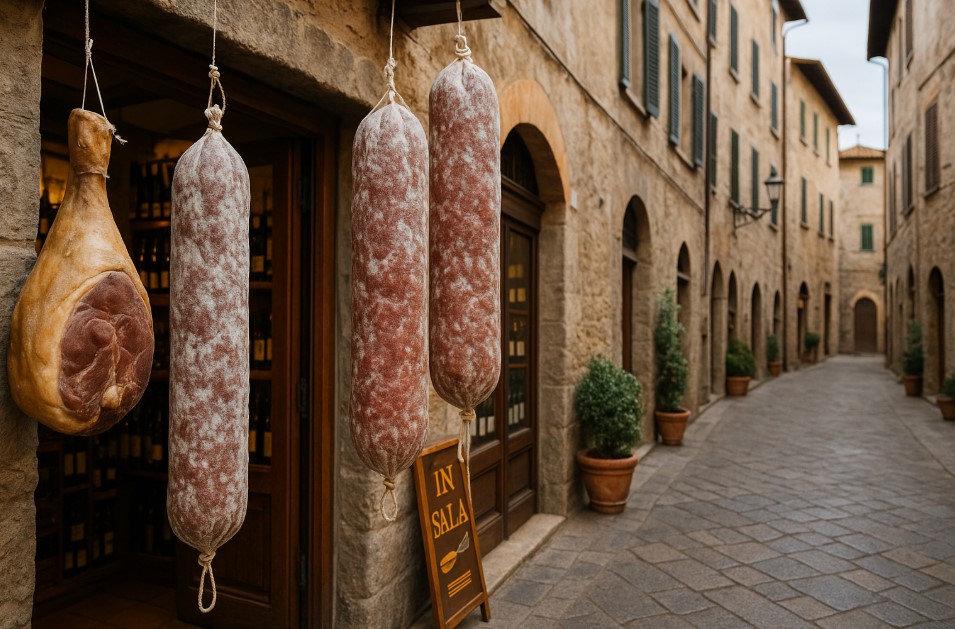Food
Hard Salami: History, Taste, and How It’s Made

Hard salami is a type of cured sausage known for its firm texture, long shelf life, and rich flavour. It is often used in sandwiches, charcuterie boards, and antipasto platters. While many types of salami exist, hard salami stands out because of its drier texture and longer curing period. It is believed to have originated in Central and Eastern Europe and has become popular worldwide. Understanding its history, taste, and production helps explain why it remains a favourite in many kitchens.
The History of Hard Salami

The history of hard salami goes back several centuries. Salami was created as a way to preserve meat before refrigeration existed. People in Europe developed methods to cure and ferment meat using salt, spices, and air drying. These techniques allowed meat to be stored for long periods without spoiling.
Hard salami is believed to have originated in Central and Eastern Europe, particularly in countries such as Germany, Hungary, and Poland. The cooler climate in these regions was well-suited for drying and ageing meat. These areas also had long traditions of sausage-making, with recipes passed down through families and local guilds.
German immigrants brought their salami-making traditions to the United States during the 19th century. Over time, local versions of hard salami were created using American ingredients and equipment. Today, it is made in many countries, but the traditional European methods still influence how it is produced.
Unlike softer salamis from southern Europe, hard salami is dried longer to remove more moisture. This gives it a firmer texture and longer shelf life. It also often uses beef or a mix of beef and pork, while many Italian salamis use mostly pork. These characteristics became standard features of hard salami.
Taste and Texture of Hard Salami
Hard salami has a firm and dense texture. It is drier than other types of salami because it is cured for a longer time, which removes more moisture. When sliced, it holds its shape well and does not crumble easily. This makes it suitable for slicing very thin without falling apart.
Its flavour is savoury, slightly tangy, and rich. The fermentation process gives it a mild acidity, while the curing develops deep, meaty flavours. It is often seasoned with garlic, black pepper, and coriander. Some versions are smoked, which adds a mild smoky flavour.
Compared to Genoa salami, hard salami is less moist and has a stronger, more concentrated flavour. It is also less fatty, giving it a firmer bite. Its flavour is not spicy but can be more intense than mild salamis. Because of its strong taste, small amounts are enough to add flavour to dishes.
Ingredients Used in Hard Salami
Hard salami is usually made from a mix of beef and pork. In some versions, only beef is used, especially in traditional German-style recipes. Lean meat is preferred to reduce excess fat, which helps achieve the dry texture.
Other common ingredients include salt, black pepper, garlic, and sometimes coriander or mustard seeds. These spices give it a classic savoury taste. Nitrate or nitrite curing salts are used to prevent bacteria and give the meat its red colour. Starter cultures are often added to control fermentation and ensure safety.
The meat and fat are ground to a medium or fine texture. The amount of fat is usually lower than in soft salamis, often around 20 to 25 percent. Less fat helps create the firmer texture.
Natural or collagen casings are used to hold the meat mixture during curing. Natural casings are made from cleaned animal intestines, while collagen casings are made from processed animal protein. Both types allow moisture to escape during drying.
The Production Process
Making hard salami involves several stages: grinding, mixing, stuffing, fermenting, and drying. Each step affects the texture, flavour, and safety of the final product.
First, the meat and fat are ground. The grinding is usually medium, not as fine as Genoa salami, to give a slightly coarser texture. The ground meat is mixed with salt, spices, curing agents, and starter cultures. This mixture is kneaded until it becomes uniform.
Next, the mixture is stuffed into casings. The casings are filled tightly to avoid air pockets, which can cause spoilage. The salamis are tied with string or placed in netting to hold their shape.
The fermentation stage comes next. The sausages are hung in a warm, humid room for one to three days. The starter cultures convert sugars into lactic acid, lowering the pH. This acid makes the meat safe to eat and adds tangy flavour.
After fermentation, the salamis are moved to a cool, humid drying room. They are hung for several weeks or months to cure. During this time, moisture slowly leaves the meat, and the flavour develops. The drying time is longer than for softer salamis, usually 6 to 10 weeks.
Airflow, humidity, and temperature are carefully controlled during drying. Too much heat or low humidity can dry the outside too quickly and trap moisture inside. Too much humidity can cause mould or spoilage.
When the salamis have lost enough moisture and reached the correct texture, they are tested for pH, water activity, and safety. If they meet food safety standards, they are packaged for sale.
Safety and Quality
Hard salami is a shelf-stable food when made correctly. The combination of salt, curing agents, fermentation, and drying prevents harmful bacteria from growing. Modern production follows strict food safety rules to ensure it is safe.
The use of starter cultures has improved safety compared to older methods. These cultures control fermentation and reduce the risk of unwanted bacteria. Most commercial producers test their salami regularly for pH, moisture content, and pathogens.
High-quality hard salami should have a firm texture, rich colour, and balanced flavour. It should not be slimy, overly soft, or have a sour smell. Some white surface mould is normal and can be wiped off. However, black or green mould is a sign of spoilage.
Differences from Other Salami Types
Hard salami differs from other salamis in several ways. It is drier, firmer, and more shelf-stable. This comes from its longer drying time and lower fat content.
It also often uses more beef than pork, while many Italian salamis are mostly pork. The flavour is more intense and less fatty than softer types like Genoa salami.
Some hard salamis are lightly smoked, which is uncommon in southern European salamis. Smoking gives a mild smoky flavour and helps preserve the meat.
Because it is drier, hard salami can be stored at room temperature longer than soft salami, though it is still best kept cool for quality.
Common Culinary Uses
Hard salami is widely used in cooking and as a ready-to-eat food. It is popular in sandwiches because it slices thinly and holds its shape. It pairs well with cheeses like Swiss, cheddar, or provolone.
It is also used on pizzas and flatbreads as a topping. The firm texture stays intact during baking. Chopped hard salami can be added to pasta salads, green salads, or grain bowls to add flavour and protein.
It is often served on charcuterie boards alongside cheeses, crackers, olives, and fruits. Because of its strong flavour, it pairs well with mild or creamy cheeses.
Hard salami can also be used in cooked dishes like omelets, casseroles, or quiches. It does not need to be cooked but can add flavour to warm dishes.
Nutritional Profile
Hard salami is high in protein and fat. A typical 28-gram serving (about one ounce) has around 120 to 140 calories, 7 to 8 grams of protein, and 10 to 12 grams of fat. It is low in carbohydrates, usually less than 1 gram per serving.
It contains sodium from the curing process, often 400 to 600 milligrams per serving. It also provides small amounts of vitamins and minerals, especially vitamin B12, zinc, iron, and niacin.
Because it is high in fat and sodium, it is best eaten in moderation. Many producers offer lower-sodium versions.
Storage and Shelf Life
Hard salami has a long shelf life because of its low moisture content. Unopened whole salami can be stored at room temperature in a cool, dry place for several weeks or even months. However, most producers recommend refrigeration to maintain the best flavour and texture.
Once opened, hard salami should be wrapped tightly in plastic wrap, foil, or placed in an airtight container in the refrigerator. It usually stays fresh for about three weeks after opening. Pre-sliced hard salami should always be refrigerated and consumed within two weeks for best quality.
If you want to store it for longer, it can be frozen. Wrap the slices or whole salami tightly to prevent freezer burn. When thawing, place it in the refrigerator and allow it to thaw slowly to maintain texture. Keep in mind that freezing can slightly change the texture, making it a bit more crumbly.
Buying Tips
Choosing good-quality hard salami can make a big difference in flavour. Here are a few things to look for when buying:
- Appearance: It should be firm, dry to the touch, and have an even red colour with white fat specks.
- Ingredients: Read the label and look for simple ingredients such as beef, pork, salt, spices, and curing agents. Avoid products with fillers, starches, or artificial flavours.
- Origin: Some traditional European-style hard salamis are made using old recipes and can have a richer flavour.
- Freshness: If buying from a deli, ask when it was sliced. Freshly sliced salami has better texture.
Whole unsliced hard salami lasts longer than pre-sliced packs. If you plan to use it slowly, buying whole pieces is a better choice.
Traditional vs Modern Production
Traditional hard salami was made using natural fermentation and slow air drying. The process could take several months and relied on natural moulds to protect the meat. The meat was hand-cut or ground, mixed with spices, stuffed into natural casings, and hung in curing rooms with natural airflow.
Modern production still follows the same basic steps but uses more controlled technology. Starter cultures are added to speed up fermentation and make it predictable. Drying takes place in temperature- and humidity-controlled rooms to ensure safety and consistency.
While traditional methods can give richer and more complex flavours, modern methods are more reliable and safer. Many high-quality producers combine traditional spice blends and long drying with modern hygiene and safety standards.
Regulations and Safety Standards
Because hard salami is not cooked, strict food safety standards apply to its production. Meat processors must follow regulations on temperature control, cleanliness, and curing times.
Most countries require producers to test the salami for pH, water activity, and microbial safety before it is sold. These tests ensure that harmful bacteria such as Listeria or Salmonella are not present.
In the European Union, many traditional salamis are protected under geographical indication rules, which means they must be made in specific regions and follow traditional recipes. In the United States, the USDA inspects and approves all commercial salami production.
These rules ensure that commercially produced hard salami is safe to eat and consistent in quality.
Cultural Importance
Hard salami has become part of food culture in many countries. In Germany, it is commonly eaten as part of breakfast or on open-faced sandwiches with bread and cheese. In Hungary and Poland, it appears on cold platters and at celebrations.
In the United States, it became a standard item in delis and grocery stores through the influence of German and Eastern European immigrants. It is now a common topping on pizzas, a filling for sandwiches, and a staple on charcuterie boards.
Although it is now mass-produced, many small producers still follow traditional recipes. This shows how hard salami has kept its cultural roots while becoming a global product.
Health Considerations
While hard salami is rich in protein and flavourful, it is also high in saturated fat and sodium. Eating it in large amounts regularly may contribute to high blood pressure or increased cholesterol. Because of this, it is best enjoyed in moderation as part of a balanced diet.
For people who need to limit sodium, there are lower-salt versions available. These can be a better choice if you want to reduce sodium while still enjoying the taste. Choosing whole-grain breads, fresh vegetables, and lower-fat cheeses to go with hard salami can also make meals more balanced.
People with food sensitivities should check the ingredients list, as some salamis may contain allergens like dairy or gluten, although traditional hard salami usually does not.
How to Use Hard Salami in Cooking
Hard salami is versatile and can be used in many ways. Some simple ideas include:
- Sandwiches and wraps: Slice thin and layer with cheese, lettuce, and condiments.
- Charcuterie boards: Combine slices with different cheeses, nuts, olives, and fruit.
- Salads: Chop into small pieces and add to green salads, pasta salads, or potato salads.
- Pizza topping: Add thin slices to pizzas before baking.
- Egg dishes: Mix chopped pieces into scrambled eggs or omelets.
- Appetisers: Roll slices around cheese sticks or vegetables.
Because it is fully cured, hard salami does not need cooking. This makes it quick and easy to use in cold or hot dishes.
Making Hard Salami at Home
It is possible to make hard salami at home, but it requires care and proper equipment. The process includes grinding, mixing, fermenting, and curing meat.
- Ingredients:5 kg beef, 0.5 kg pork fat, 60 g salt, 6 g curing salt, 10 g black pepper, 15 g garlic, 200 ml red wine, starter cultures.
- Grinding: Grind the meat and fat to medium size.
- Mixing: Combine meat, fat, salt, spices, garlic, wine, and starter cultures until sticky.
- Stuffing: Fill into casings tightly to remove air.
- Fermentation: Hang at 22°C and high humidity for 48 hours.
- Curing: Move to a chamber at 12–15°C with 70–75% humidity for 6 to 10 weeks. Turn occasionally.
- Testing: When it has lost about 30% of its weight and is firm, it is ready.
This process must be done under strict hygiene and temperature control. Because of the risk of bacteria, beginners should carefully study safety methods or start with simpler cured meats first.
Final Thoughts
Hard salami is a traditional cured meat with a long history in central and eastern Europe. It is known for its firm texture, rich savoury flavour, and long shelf life. It is made from beef or a mix of beef and pork, seasoned with garlic and spices, and cured for several weeks until dry.
It has become part of many cuisines around the world and is commonly used in sandwiches, pizzas, salads, and charcuterie boards. While it is high in protein, it also contains fat and sodium, so it is best eaten in moderation.
Knowing its history, taste, and production helps explain why hard salami remains a popular and trusted food. Whether enjoyed on its own or as part of a dish, it continues to be valued for its unique qualities and lasting place in food culture.
Learn about: Genoa Salami: History, Taste, and How It’s Made
-

 Social Media2 months ago
Social Media2 months agoWhat the “67” TikTok Meme Really Means
-

 Tech2 months ago
Tech2 months agoWhat To Do When Your Business Faces Network Vulnerabilities
-

 Self Improvement2 months ago
Self Improvement2 months agoUsing BCBS Rehab to Access Quality Addiction Care
-

 Games2 months ago
Games2 months agoPusoy Strategies for Play That Also Work in Pusoy Dos in English






